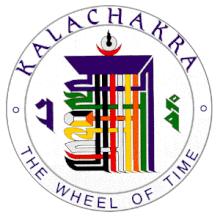Bodong tradition
| Tibetan name |
|---|
|
Tibetan script :
བོ་ དོང་ པ
|
|
Wylie transliteration : bo dong pa
|
|
Other spellings: Bodongpa
|
| Chinese name |
|
Simplified :
珀 东 派;
博 东 派 |
|
Pinyin : Podong pai;
Bodong pai |
The Bodong tradition , Tibetan Bodongpa ( Tib . : bo dong pa ), describes a sub-school of the Sakya tradition of Tibetan Buddhism . The Sakya tradition is one of the four great Buddhist traditions ( Nyingma , Kagyu , Sakya and Gelug ) in Tibet.
The first Bodong monastery was founded in 1049 by Kadampa Geshe Mudra Chenpo ( bka 'dams pa dge bshes mu tra chen po ). The most famous scholar of the Bodong tradition was Bodong Penchen Chögle Namgyel (Tib .: bo dong paN chen phyogs las rnam rgyal ; 1376–1451). He was a master of 23 Buddhist fields of knowledge, including the five traditional sciences Vinaya , Sutra , Abhidharma , Prajnaparamita and logic , and a master of Mahayana Shastras, Tantras and Tantric arts. He preserved the traditions of Sakya Pandita and the Kalachakra lineage. In his day these traditions were in great demand; he is said to have given teachings to more than 10,000 students. However, these days this line is no longer widely used. A well-known Trülku line of the Bodong tradition is that of Samding Dorje Phagmos .
literature
- Mei Ching Hsuan 梅靜軒: The Development of 'Pho ba Liturgy in Medieval Tibet . Bonn 2009 (Diss.) ( Online )
- Jill Sudbury: An Enigmatic Renaissance: The Revival of the Bodongpa Tradition of Tibetan Buddhism . (2007)
Web links
- www.bodong.info: The Bodong Tradition ( Memento from May 6, 2008 in the Internet Archive )
- tibetanlineages.org: Bodong
- tibet-lahr.de: Passionate and angry wisdom dakinis (Simhamukha according to the Sakyapa tradition) - John Myrdhin Reynolds
Individual evidence
- ↑ http://tbrc.org/link?RID=P2627 ( page no longer available , search in web archives ) Info: The link was automatically marked as defective. Please check the link according to the instructions and then remove this notice.
